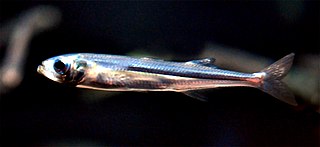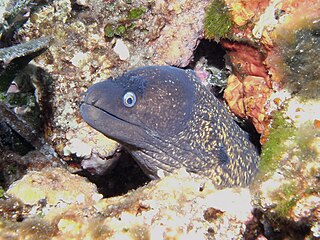
Groupers are fish of any of a number of genera in the subfamily Epinephelinae of the family Serranidae, in the order Perciformes.

Moray eels, or Muraenidae, are a family of eels whose members are found worldwide. There are approximately 200 species in 15 genera which are almost exclusively marine, but several species are regularly seen in brackish water, and a few are found in fresh water.
The Mastacembelidae are a family of fishes, known as the spiny eels. The Mastacembelids are part of the Order Synbranchiformes, the swamp eels, which are part of the Actinopterygii.

The Congridae are the family of conger and garden eels. Congers are valuable and often large food fishes, while garden eels live in colonies, all protruding from the sea floor after the manner of plants in a garden. The family includes over 220 species in 32 genera.

The superorder Elopomorpha contains a variety of types of fishes that range from typical silvery-colored species, such as the tarpons and ladyfishes of the Elopiformes and the bonefishes of the Albuliformes, to the long and slender, smooth-bodied eels of the Anguilliformes. The one characteristic uniting this group of fishes is they all have leptocephalus larvae, which are unique to the Elopomorpha. No other fishes have this type of larvae.

Gymnothorax is a genus of fish in the family Muraenidae found in Atlantic, Indian, and Pacific Oceans. With more than 120 species, it the most speciose genus of moray eels.

The Chlopsidae, or false morays, are a family of marine ray-finned fishes belonging to the order Anguilliformes, the eels. The eels in this family arefound in coral reefs worldwide. As their name suggests, they somewhat resemble moray eels in appearance. However, they are smaller than true morays, ranging from 11 to 42 cm in length.
Scuticaria okinawae is a moray eel found in the Pacific and Indian Oceans. It is commonly known as the shorttailed snake moray, shorttail moray, Seale's moray eel, or the Bennett's moray.

The Congrinae are a subfamily of eels in the family Congridae.
Uropterygius oligospondylus is a moray eel.

Bathymyrinae is a subfamily of marine ray-finned fishes belonging to the family Congridae, which includes the conger and garden eels. The eels of this subfamily are most diverse in the Indo-Pacific region but are also found in both the Eastern and Western Atlantic Oceans.

Myrophinae, the worm eels, is a subfamily of ray-finned fishes belonging to the family Ophichthidae, which also includes the snake eels in the subfamily Ophichthinae.

Congroidei is a suborder of ray-finned fishes belonging to the order Anguilliformes, the eels. These eels are mostly marine, although a few species of snake eel will enter freshwater, and they are found in tropical and tempareate waters throughout the world.

Ophidiinae is a subfamily of the cusk eel family Ophidiidae. The species in the subfamily are characterised by having their pelvic fins situated far forward on the body and supported by a forward orientated extension of the pelvic girdle, they lack barbels on the mouth and chin and they are covered in small cycloid scales arranged in horizontal or diagonal rows. Some species have a modified swim bladder and the anterior vertebrae which enables them to generate sounds. and some of these modifications are sexually dimorphic and make the fish capable of generating sound. They have two rays in each ventral fin and the caudal fin has 9 rays. Most species are benthic and occur on the continental shelf.

Atherinoidei is a suborder of the order Atheriniformes comprising six families, with a mainly Old World distribution, although a few species are found in the western Atlantic Ocean.

Synbranchinae is a subfamily of swamp eel, consisting of six of the ten genera in the family Synbranchidae. The remaining genus, the monotypic Macrotrema is the only one in the other subfamily Macrotreminae. The subfamily occurs in the Neotropics, Afrotropics and Asia.

Muraenoidei is a suborder of mainly marine ray-finned fishes belonging to the order Anguilliformes, the eels. The eels in this suborder are distributed in the tropical and temperate seas around the world.

Acanthuriformes is an order of ray-finned fishes, part of the Percomorpha clade. Some authorities place the fishes in the order within the Acanthuriformes in the suborders Acanthuroidea and Percoidea of the order Perciformes.

Scorpaenini is a tribe of marine ray-finned fishes, one of two tribes in the subfamily Scorpaeninae. This tribe contains the "typical" or "true" scorpionfishes. The taxonomy of the scorpionfishes is in some flux, the 5th Edition of Fishes of the World treats this taxa as a tribe within the subfamily Scorpaeninae of the family Scorpaenidae within the order Scorpaeniformes, while other authorities treat it as a subfamily within a reduced family Scorpaenidae within the suborder Scorpaenoidei, or the superfamily Scorpaenoidea within the order Perciformes.

Ilyophinae, the arrowtooth ells or mustard eels, is a subfamily of marine ray-finned fishes belongiing to the family Synaphobranchidae, the cutthroat eels. Within its family this subfamily shows greatest number of species and the greatest morphological diversity.

















